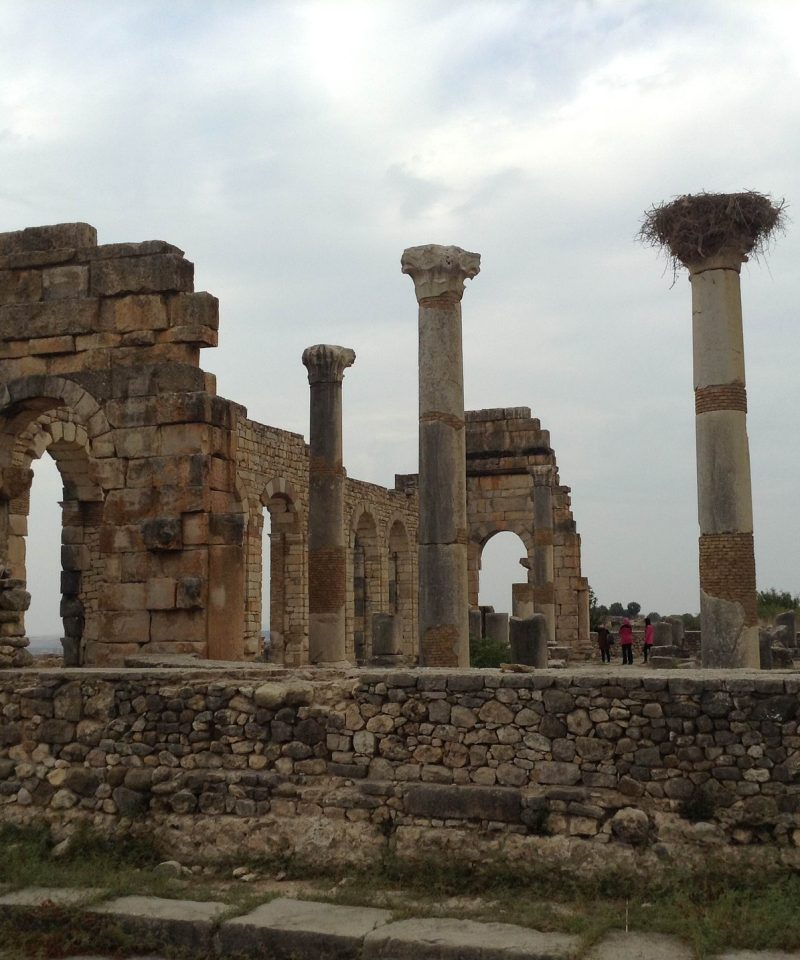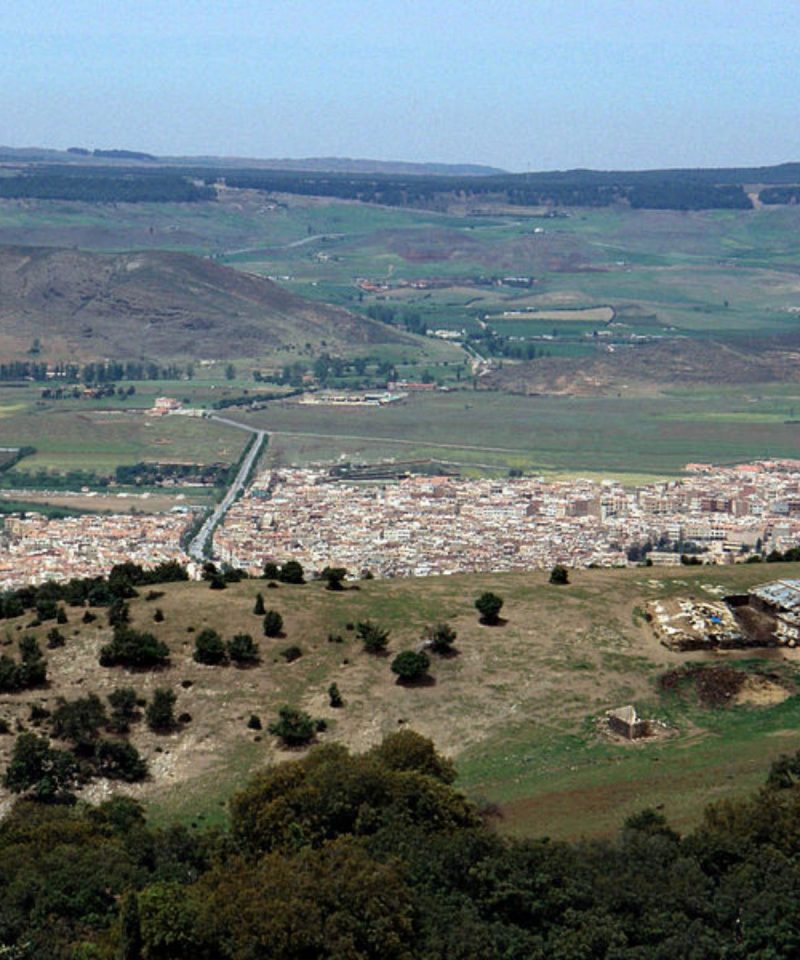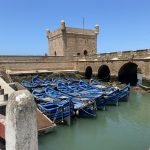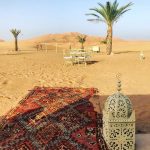History
Foundation and the Idrisids
The city was first founded in 789 as Madinat Fas on the southeast bank of the Jawhar River (now known as the Fez River) by Idris I, founder of the Idrisid dynasty. His son, Idris II, built a settlement called Al-‘Aliya on the opposing river bank in 809 and moved his capital here from Walili (Volubilis). The early population was composed mostly of Berbers, along with hundreds of Arab warriors from Kairouan who made up Idris II’s entourage.
Arab emigration to Fez increased afterwards. Andalusi families of mixed Arab and Iberian descent, who were expelled from Córdoba after a rebellion in 817–818 against al-Hakam I, were one major component of this. These families mainly settled in Madinat Fas. Additionally, Arab families banned from Kairouan (in present-day Tunisia) after a rebellion there in around 825 also arrived and were settled in Al-‘Aliya. These two waves of immigrants gave the city its Arabic character and would subsequently give their name to the districts of ‘Adwat Al-Andalus [ar] and ‘Adwat al-Qarawiyyin [ar]. The city also had a strong Jewish community, probably consisting of Zenata Berbers who had previously converted to Judaism, as well as a small remaining Christian population for a time. The Jews were especially concentrated in a northeastern district of Al-‘Aliya, known as Funduq el-Yihoudi (near the present-day Bab Guissa gate).
Following the death of Idris II in 828 the region was divided among his sons. The eldest, Muhammad, received Fez, but some of his brothers attempted to break away from his leadership, resulting in an internecine conflict. Although the Idrisid realm was eventually reunified and enjoyed a period of peace under Ali ibn Muhammad and Yahya ibn Muhammad, it fell into decline again in the late 9th century. According to one of the major early sources on this period, the Rawd al-Qirtas by Ibn Abi Zar, in this period the Al-Qarawiyyin Mosque was founded in 859 by Fatima al-Fihri, the daughter of a wealthy merchant. Her sister, Mariam, is likewise reputed to have founded the Al-Andalusiyyin Mosque the same year.
In the 10th century, the city was contested by the Umayyad Caliphate of Córdoba and the Fatimid Caliphate of Ifriqiya (Tunisia), who ruled the city through a host of Zenata clients. The Fatimids took the city in 927 and expelled the Idrisids definitively, after which their Miknasa (one of the Zenata tribes) were installed there. The city, along with much of northern Morocco, continued to change hands between the proxies of Córdoba and the proxies of the Fatimids for many decades. Following another successful invasion by Buluggin ibn Ziri in 979 and a brief period of Fatimid control, the forces of Al-Mansur of Cordoba managed to retake the region again, expelling the Fatimids permanently. From 980 (or from 986), Fez was ruled by a Zenata dynasty from the Maghrawa tribe, who were allies of the Caliphate of Córdoba. They maintained this control even after the Caliphate’s collapse in the early 11th century and until the arrival of the Almoravids.
Fez continued to grow under Zenata control, even though conflicts between its two settlements, Madinat Fas and Al-‘Aliya, flared up during periods of political rivalry. Ziri ibn Atiyya, the first ruler of the new dynasty, had a troubled reign. However, Ibn Atiyya’s descendant Dunas ibn Hamama, ruling between 1037 and 1049, was responsible for improving the city’s infrastructure. He developed much of Fez’s water supply system, which has largely survived up to the present day. Other structures built in his time included hammams (bathhouses), mosques, and the first bridges over the Oued Bou Khrareb (mostly rebuilt in later eras). The two cities became increasingly integrated: the open space between the two was filled up by new houses and up to six bridges across the river allowed for easier passage between them. A decade after Dunas, between 1059 and 1061, the two cities were ruled separately by two rival Zenata emirs who fought with each other: Al-‘Aliya was controlled by an emir named Al-Gisa and Madinat Fas was controlled by Al-Fetouh. Both brothers fortified their respective shores, and their names have been preserved in two of the city’s gates to this day: Bab Guissa (or Bab Gisa) in the north and Bab Ftouh in the south.
Golden age: under the Almoravids, Almohads, and Marinids
In 1069–1070 (or possibly a few years later), Fez was conquered by the Almoravids under Yusuf ibn Tashfin. In the same year of this conquest, Yusuf ibn Tashfin unified Madinat Fas and Al-‘Aliya into one city. The walls dividing them were destroyed, bridges connecting them were built or renovated, and a new circuit of walls was constructed that encompassed both cities. A kasbah (citadel) was built at the western edge of the city (just west of Bab Bou Jeloud today) to house the city’s governor and garrison. Under Almoravid patronage, the largest expansion and renovation of the Great Mosque of al-Qarawiyyin took place (1135–1143). Although the capital was moved to Marrakesh under the Almoravids, Fez acquired a reputation for Maliki legal scholarship and remained an important centre of trade and industry. Almoravid impact on the city’s structure was such that Yusuf ibn Tashfin is sometimes considered to be the second founder of Fez.
In 1145 the Almohad leader Abd al-Mu’min besieged and conquered the city during the Almohad overthrow of the Almoravids. Due to the ferocious resistance they encountered from the local population, the Almohads demolished the city’s fortifications. However, due to Fez’s continuing economic and military importance, the Almohad caliph Ya’qub al-Mansur ordered the reconstruction of the ramparts. Since the city had grown in the meantime, the new Almohad perimeter of walls was larger than that of the former Almoravid ramparts. The walls were completed by his successor Muhammad al-Nasir in 1204, giving them their definitive shape and establishing the perimeter of Fes el-Bali to this day. The Almohads built the Kasbah Bou Jeloud on the site of the former Almoravid kasbah and also built the first kasbah occupying the site of the current Kasbah an-Nouar. Not all the land within the city walls was densely inhabited; much of it was still relatively open and was occupied by crops and gardens used by the inhabitants. During the 12th century, the city was one of the largest in the world, with an estimated population of 200,000.
In 1250, Fez regained its status as the capital under the Marinid dynasty. The city reached its golden age in the Marinid period. In 1276, an anti-Marinid revolt resulted in a massacre of the Jewish community that was stopped by the intervention of the ruler Abu Yusuf Ya’qub. Following the revolt, Abu Yusuf Yaqub founded Fes Jdid as the new administrative and military centre. Under the Marinids, many of the principal monuments in the medina were built and the city established its reputation as an important intellectual centre. Between 1271 and 1357 seven madrasas were built, which are among the best examples of Moroccan architecture and some of the most richly decorated monuments in Fez.
The Jewish quarter of Fez, the Mellah, was created in Fes Jdid at some point during the Marinid period. The exact date and circumstances of its formation are not firmly established, but many scholars date the transfer of the Jewish population from Fes el-Bali to the new Mellah to the 15th century, a period of political tension and instability. In particular, Jewish sources describe the transfer as a consequence of the “rediscovery” of Idris II’s body in the heart of the city in 1437, which caused the surrounding area – if not the entire city – to acquire a “holy” (haram) status, requiring that non-Muslims be removed from the area. The Jewish community had initially consisted of indigenous local Jews but these were joined by Sephardic Jews from the Iberian Peninsula (known as the Megorashim) in subsequent generations, especially after the 1492 expulsion of Jews from Spain.
The 1465 Moroccan revolt overthrew the last Marinid sultan. In 1472 the Wattasids, another Zenata dynasty which had previously served as viziers under the Marinid sultans, succeeded as rulers of Morocco from Fez. They perpetuated the structure of the Marinid state and continued its policies, but were unable to control all of Morocco. They did not contribute significantly to the physical fabric of Fez.
Sharifian rule: under the Saadians and Alaouites
In the 16th century the Saadis, a dynasty claiming prophetic heritage, rose to power in southern Morocco and challenged the Wattasids. Around the same time, the Ottoman Empire came close to Fez after its conquest of Algeria. In January 1549, the Saadi sultan Mohammed ash-Sheikh took Fez and ousted the last Wattasid sultan Ali Abu Hassun. The Wattasids later retook the city in 1554 with Ottoman support, but this reconquest was short-lived and later that same year the Wattasids were decisively defeated by the Saadis. The Ottomans attempted to invade Morocco after the assassination of Mohammed ash-Sheikh in 1558, but were stopped by his son Abdallah al-Ghalib at the Battle of Wadi al-Laban north of Fez. After the death of Abdallah al-Ghalib a new power struggle emerged. Abd al-Malik, Abdallah’s brother, captured Fez with Ottoman support and ousted his nephew Abu Abdullah from the throne. The latter fled to Portugal where he asked king Sebastian of Portugal for help to regain his throne, while Abd al-Malik accepted Ottoman suzerainty. This led to the Battle of Wadi al-Makhazin (also known as Battle of the Three Kings) in which Abd al-Malik’s army defeated the invading Portuguese army, ensuring Moroccan independence. Abd al-Malik was killed during the battle and was succeeded by Ahmad al-Mansur (r. 1578–1603).
The Saadians, who used Marrakesh again as their capital, did not lavish much attention on Fez, with the exception of the ornate ablutions pavilions added to the Qarawiyyin Mosque’s courtyard during their time. Perhaps as a result of persistent tensions with the city’s inhabitants, the Saadians built a number of new forts and bastions around the city which appear to have been aimed at keeping control over the local population.
After the long reign of Ahmad al-Mansur, the Saadian state fell into civil war between his sons and potential successors. Fez became a rival seat of power for a number of brothers vying against other family members ruling from Marrakesh. Both cities changed hands multiple times until the internecine conflict finally ended in 1627. Despite the reunification of the realm after 1627, the Saadians were in full decline and Fez had already suffered considerably from the repeated conquests and reconquests during the conflict. In 1641, Muhammad al-Haj of the Sanhaja Amazigh Dilā’ Sufi order occupied Fes. The time was particularly difficult for Fessi Jews.
It was only when the founder of the Alaouite dynasty, Moulay Rashid, took Fez in 1666 that the city saw a revival and became the capital again, albeit briefly. Moulay Rashid set about restoring the city after a long period of neglect. He built the Kasbah Cherarda (also known as the Kasbah al-Khemis) to the north of Fes Jdid in order to house a large part of his tribal troops. He also restored or rebuilt what became known as the Kasbah an-Nouar, which became the living quarters of his followers from the Tafilalt region (the Alaouite dynasty’s ancestral home). For this reason, the kasbah was also known as the Kasbah Filala (“Kasbah of the people from Tafilalt”). Moulay Rashid also built a large new madrasa, the Cherratine Madrasa, in 1670. After his death Fez underwent another dark period. Moulay Isma’il, his successor, apparently disliked the city – possibly due to a rebellion there in his early reign – and chose nearby Meknès as his capital instead. Although he did restore or rebuild some major monuments in the city, such as the Zawiya of Moulay Idris II, he also frequently imposed heavy taxes on the city’s inhabitants and sometimes even forcibly transferred parts of its population to repopulate other cities in the country. After his death, Morocco was plunged into anarchy and decades of conflict between his sons who vied to succeed him. Fez suffered particularly from repeated conflicts with the Udayas (or Oudayas), a guich tribe (vassal tribe serving as a garrison and military force) previously installed in the Kasbah Cherarda by Moulay Isma’il. Sultan Moulay Abdallah, who reigned intermittently during this period and used Fez as a capital, was initially welcomed in 1728–29 as an enemy of the Udayas, but relations between him and the city’s population quickly soured due to his choice of governor. He immediately built a separate fortified palace in the countryside, Dar Dbibegh, where he resided instead. For nearly three more decades the city remained in more or less perpetual conflict with both the Udayas and the Alaouite sultans.
Starting with the reign of Moulay Muhammad ibn Abdallah, between 1757 and 1790, the country stabilized and Fez finally regained its fortunes. Although its status was partly shared with Marrakesh, it remained the capital of Morocco for the rest of the Alaouite period up to the 20th century. There was a brief period of disorder under Moulay Yazid (ruled 1790–1792) and Moulay Slimane (ruled 1792–1822), with the sultans in Fez losing control of most of the rest of Morocco between 1790 and 1795. However, the city benefitted from a long era of relative peace and remained a major economic center even during short periods of conflict. The Alaouites continued to rebuild or restore various monuments and undertook a series of extensions to the Royal Palace. The sultans and their entourages also became more and more closely associated with the elites of Fez and other urban centers, with the ulama (religious scholars) of Fez being particularly influential. After Moulay Slimane’s death, powerful Fassi families became the main players of the country’s political and intellectual scene.
The Tijani Sufi order, started by Ahmad al-Tijani (d. 1815), has had its spiritual center in Fez since al-Tijani moved here from Algeria in 1789. The order spread quickly among the literary elite of North West Africa and its ulama had significant religious, intellectual, and political influence in Fez and beyond. Until the 19th century the city was the only source of fezzes (also known as the tarboosh).
The last major change to Fez’s topography before the 20th century was made during the reign of Moulay Hassan I (1873-1894), who finally connected Fes Jdid and Fes el-Bali by building a walled corridor between them. New gardens and summer palaces, used by the royals and the capital’s high society, were built within the corridor, such as the Jnan Sbil Gardens and the Dar Batha palace. Moulay Hassan also expanded the old Royal Palace itself, extending its entrance up to the current location of the Old Mechouar while adding the New Mechouar, along with the Dar al-Makina, to the north. The expansion separated the Moulay Abdallah neighbourhood to the northwest from the rest of Fes Jdid.
Fez played a central role in the Hafidhiya, the brief civil war that erupted when Abdelhafid challenged his brother Abdelaziz for the throne. The ulama of Fez, led by the Sufi modernist Muhammad Bin Abdul-Kabir Al-Kattani, offered their conditioned support to Abd al-Hafid, which turned the tide of the conflict. Abdelaziz was defeated in the Battle of Marrakesh in 1908. Abdelhafid’s reign soon deteriorated and in early 1911 the sultan was besieged in Fez by the tribes of the Middle Atlas. Abdelhafid appealed for French help and a French force under Colonel Charles Émile Moinier [fr] arrived in Fez on May 21 and established a command centre at Dar Dbibegh.
Colonial rule
In 1912, French colonial rule was instituted over Morocco following the Treaty of Fes. One immediate consequence was the 1912 riots in Fez, a popular uprising which included deadly attacks targeting Europeans as well as native Jewish inhabitants in the Mellah, followed by an even deadlier repression. The first French resident general, Hubert Lyautey, decided to move the administrative capital of the Protectorate to Rabat in 1912–1913, which has remained the capital ever since.
A number of social and physical changes took place during this period and across the 20th century. Starting under Lyautey, one important policy with long-term consequences was the decision to largely forego redevelopment of existing historic walled cities in Morocco and to intentionally preserve them as sites of historic heritage, still known today as “medinas”. Instead, the French administration built new modern cities (the Villes Nouvelles) just outside the old cities, where European settlers largely resided with modern Western-style amenities. This was part of a larger “policy of association” adopted by Lyautey which favoured various forms of indirect colonial rule by preserving local institutions and elites, in contrast with other French colonial policies that had favoured “assimilation”. The Ville Nouvelle also became known as Dar Dbibegh by Moroccans, as the former palace of Moulay Abdallah was located in the same area.
The creation of the separate French Ville Nouvelle to the west had a wider impact on the entire city’s development. While new colonial policies preserved historic monuments, it also had other consequences in the long-term due to stalling urban development in these heritage areas. Scholar Janet Abu-Lughod has argued that these policies created a kind of urban “apartheid” between the indigenous Moroccan urban areas, who were forced to remain stagnant in terms of urban development and architectural innovation, and the new, mainly European-inhabited planned cities, which expanded to occupy lands formerly used by Moroccans outside the city. This separation was partly softened, however, by wealthy Moroccans who started moving into the Ville Nouvelles during this period. By contrast, the old city (medina) of Fez was increasingly settled by poorer rural migrants from the countryside.
Fez also played a role in the Moroccan nationalist movement and in protests against the French colonial regime. Many Moroccan nationalists received their education at the Al-Qarawiyyin University and some of their informal political networks were established thanks to this shared educational background. In July 1930, the students and other inhabitants protested against the Berber Dahir, decreed by the French authorities in May of that year. In 1937, the Al-Qarawiyyin Mosque and R’cif Mosque were rallying points for demonstrations against a violent crackdown on Moroccan protesters in the nearby city of Meknes, which ended with French troops being deployed across Fes el-Bali, including at the mosques themselves. Towards the end of World War II, Moroccan nationalists gathered in Fez to draft a demand for independence which they submitted to the Allies on January 11, 1944. This resulted in the arrest of nationalist leaders followed by the violent suppression of protests across many cities, including Fez.
Independence and present day
After Morocco regained its independence in 1956 many of the trends begun under colonial rule continued and accelerated during the second half of the 20th century. Much of Fez’s bourgeois classes moved to the growing metropolises of Casablanca and the capital, Rabat. The Jewish population was particularly depleted, either moving to Casablanca or emigrating to countries like France, Canada, and Israel. Although the population of the city grew, it did so only slowly up until the late 1960s, when the pace of growth finally accelerated. Throughout this period (and up to today) Fez nonetheless remained the country’s third largest urban center. Between 1971 and 2000, the population of the city roughly tripled from 325,000 to 940,000. The Ville Nouvelle became the locus of further development, with new peripheral neighbourhoods–with inconsistent housing quality–spreading outwards around it. In 1963 the University of Al-Qarawiyyin was reorganized as a state university, while a new public university, Sidi Mohamed Ben Abdellah University, was founded in 1975 in the Ville Nouvelle. In 1981, the old city, consisting of Fes el-Bali and Fes Jdid, was classified as a UNESCO World Heritage Site.
Social inequalities and economic precarity were accentuated during the repressive reign of King Hassan II and the period known as the Years of Lead (roughly 1975–1990). Fez was strongly affected by unemployment and lack of housing. Austerity measures led to several riots and uprisings across other cities during the 1980s. On December 14, 1990, a general strike was called and led to protests and rioting by university students and youths in Fez. Buildings were burned and looted, including the Hôtel des Mérinides, a luxury hotel overlooking Fes el-Bali and dating to the time of Lyautey. Thousands were arrested and at least five were killed. The government promised to investigate and raise wages, though some of these measures were dismissed by the opposition.
Today Fez remains a regional capital and one of Morocco’s most important cities. Many of the former notable families of Fez still make up a large part of the country’s political elite. It is also a major tourism destination due to its historical heritage. In recent years efforts have been underway to restore and rehabilitate the old medina, ranging from the restoration of individual monuments to attempts to rehabilitate the Fez River.
Geography
Location
The city is divided between its historic medina (the two walled districts of Fes el-Bali and Fes Jdid) and the now much larger Ville Nouvelle (New City) along with several outlying modern neighbourhoods. The old city is located in a valley along the banks of the Oued Fes (Fez River) just above its confluence with the larger Sebou River to the northeast. The Fez River takes its sources from the south and west and is split into various small canals which provide the historic city with water. These in turn empty into the Oued Bou Khrareb, the stretch of the river which passes through the middle of Fes el-Bali and separates the Qarawiyyin quarter from the Andalusian quarter.
The new city occupies a plateau on the edge of the Saïs plain. The latter stretches out to the west and south and is occupied largely by farmland. Roughly 15 km south of Fes el-Bali is the region’s main airport, Fes-Saïs. Further south is the town of Sefrou, while the city of Meknes, the next largest city in the region, is located to the southwest.
Landmarks
Medina of Fez
The historic city of Fez consists of Fes el-Bali, the original city on both shores of the Oued Fes (River of Fez), and the smaller Fez Jdid, founded on higher ground to the west in the 13th century. It is distinct from Fez’s now much larger Ville Nouvelle (new city). Fes el-Bali is the site of the famous Qarawiyyin University and the Zawiya of Moulay Idris II, the most important religious and cultural sites, while Fez el-Jdid is the site of the 195 acre Royal Palace, still used by the King of Morocco today. These two historic cities are linked together and are usually referred to together as the “medina” of Fez, though this term is sometimes applied more restrictively to Fes el-Bali only.
Fez is becoming an increasingly popular tourist destination and many non-Moroccans are now restoring traditional houses (riads and dars) as second homes in the medina. In 1981, the United Nations Educational, Scientific and Cultural Organization (UNESCO) designated Medina of Fez a World Heritage site, describing it as “one of the most extensive and best conserved historic towns of the Arab-Muslim world.” It was the first site in Morocco to be granted this status.
Places of worship
There are numerous historic mosques in the medina, some of which are part of a madrasa or zawiya. Among the oldest still standing today are the Mosque of al-Qarawiyyin, founded in 857 and subsequently expanded, the Mosque of the Andalusians founded in 859–860, the Bou Jeloud Mosque from the late 12th century, and possibly the Mosque of the Kasbah en-Nouar (which may have existed in the Almohad period but was likely rebuilt much later). The very oldest mosques of the city, dating back to its first years, were the Mosque of the Sharifs (or Shurafa Mosque) and the Mosque of the Sheikhs (or al-Anouar Mosque); however, they no longer exist in their original form. The Mosque of the Sharifs was the burial site of Idris II and evolved into the Zawiya of Moulay Idris II that exists today, while the al-Anouar Mosque has left only minor remnants.
A number of mosques from the important Marinid era, when Fes Jdid was created to be the capital of Morocco, include the Great Mosque of Fez el-Jdid from 1276, the Abu al-Hasan Mosque from 1341, the Chrabliyine Mosque from 1342, and the al-Hamra Mosque from around the same period. The Bab Guissa Mosque was also founded in the reign of Abu al-Hasan (1331-1351), but modified in later centuries. Other major mosques from the more recent Alaouite period are the Moulay Abdallah Mosque, built in the early to mid-18th century with the tomb of Sultan Moulay Abdallah, and the R’cif Mosque, built in the reign of Moulay Slimane (1793-1822). The Zawiya of Moulay Idris II and the Zawiya of Sidi Ahmed al-Tijani include mosque areas as well, as do several other prominent zawiyas in the city. The Ville Nouvelle also includes many modern mosques, the largest of which is the Imam Malik Mosque which opened in 1994.
Elsewhere, the Jewish quarter (Mellah) is the site of the 17th-century Al-Fassiyin Synagogue and Ibn Danan Synagogue, as well multiple other lesser-known synagogues, though none of them are functioning today. According to the World Jewish Congress there are only 150 Moroccan Jews remaining in Fes. The Church of Saint Francis of Assisi, the only Catholic church in Fez, was established in 1919 or 1920, during the French colonial period. The current building was constructed in 1928 and expanded in 1933. Today it is part of the Archdiocese of Rabat, and it was most recently restored in 2005.
Madrasas
The Madrasa (or University) of al-Qarawiyyin was established in 857 by Fatima al-Fihri, originally as a mosque. It is the oldest existing and continually operating degree-awarding educational institution in the world according to UNESCO and Guinness World Records. The Marinid dynasty devoted great attention to the construction of madrasas following the Maliki orthodoxy, resulting in the unprecedented prosperity of the city’s religious institutions. The first madrasa built during the Marinid era was the Saffarin Madrasa in Fes el-Bali by Sultan Abu Yusuf in 1271. Sultan Abu al-Hasan was the most prolific patron of madrasa construction, completing the Al-Attarine, Mesbahiyya and Sahrij Madrasas. His son Abu Inan Faris built the Bou Inania Madrasa, and by the time of his death, every major city in the Marinid Empire had at least one madrasa. The library of al-Qarawiyyin, which holds a large collection of manuscripts from the medieval era, was also established under Marinid rule around 1350. The largest madrasa in the medina is Cherratine Madrasa, which was commissioned by the Alaouite sultan Al-Rashid in 1670 and is the only major non-Marinid foundation besides the Madrasa of al-Qarawiyyin.
Tombs and mausoleums
Located in the heart of Fes el-Bali, the Zawiya of Moulay Idris II is a zawiya (a shrine and religious complex; also spelled zaouia), dedicated to and containing the tomb of Idris II (or Moulay Idris II when including his sharifian title) who is considered the main founder of the city of Fez. Another well-known and important zawiya is the Zawiyia of Sidi Ahmed al-Tijani, which commemorates Sidi Ahmed al-Tijani, the founder of Tijaniyyah tariqa from the 18th century. A number of zawiyas are scattered elsewhere across the city, many containing the tombs of important Sufi saints or scholars, such as the Zawiya of Sidi Abdelkader al-Fassi, the Zawiya of Sidi Ahmed esh-Shawi, and the Zawiya of Sidi Taoudi Ben Souda.
The old city contains several major historic cemeteries which stand outside the walls of Fes el-Bali, namely the cemeteries of Bab Ftouh (the most significant), Bab Mahrouk, and Bab Guissa. Some include marabouts or domed structures, containing the tombs of local Muslim saints (often considered Sufis), for example the Marabout of Sidi Harazem in the Bab Ftouh Cemetery. The ruins of the Marinid Tombs, built during the 14th century as a necropolis for the Marinid sultans, are close to the Bab Guissa Cemetery.
Fortifications
The entire medina of Fez was heavily fortified with crenelated walls with watchtowers and gates, a pattern of urban planning which can be seen in Salé and Chellah as well. The oldest sections of the walls today, on the north side of Fes el-Bali, date back to the Almohad period. The gates of Fez, scattered along the circuit of walls, were guarded by the military detachments and shut at night. Some of the main gates have existed, in different forms, since the earliest years of the city. The oldest gates today, and historically the most important ones of Fes el-Bali, are Bab Mahrouk (in the west), Bab Guissa (in the northeast), and Bab Ftouh (in the southeast). The main gates of Fes Jdid include Bab Dekkakin, Bab Semmarine, and Bab al-Amer. In modern times, the function of gates became more ceremonial rather than defensive, as reflected by the 1913 construction of the decorative Bab Bou Jeloud gate at the western entrance of Fes el-Bali by the French colonial administration.
Several forts were constructed along the defensive perimeters of the medina during different time periods. A “kasbah” in the context of Maghrebi region is the traditional military structure for fortification, military preparation, command and control. Some of them were occupied as well by citizens, certain tribal groups, and merchants. Throughout the city’s history, 13 kasbahs were constructed. Among them is the Kasbah an-Nouar, the Kasbah Tamdert, and the Kasbah Cherarda. The Saadis also built a number of bastions and forts in the late 16th century including Borj Nord and its sister fort, Borj Sud.
Tanneries
Since the city’s foundation, the tanning industry has been continually operating in Fez and is considered one of the main tourist attractions. There are three tanneries in the city, largest among them is Chouara Tannery near the Saffarin Madrasa along the river. The tanneries are packed with the round stone wells filled with dye or white liquids for softening the hides. The leather goods produced in the tanneries are exported around the world. The two other major tanneries are the Sidi Moussa Tannery to the west of the Zawiya of Moulay Idris II and the Ain Azliten Tannery in the neighbourhood of the same name on the northern edge of Fes el-Bali.
Historic palaces and residences
Many old private residences have also survived to this day, in various states of conservation. The typical traditional house (dar) is centered around an internal courtyard. Some of these houses also had internal gardens known as a riad. Such private houses include the Dar al-Alami, the Dar Saada (now a restaurant), Dar ‘Adiyil, Dar Belghazi, and others. Larger and richer mansions, such as the Dar Mnebhi, Dar Moqri, and Jamai Palace, have also been preserved. Numerous traditional houses, popularly known as “riads”, are now utilized as hotels for the tourism industry. The Jamai Palace was converted into a luxury hotel, known as Palais Jamaï, in the early 20th century. The lavish former mansion of the Glaoui clan, known as the Dar Glaoui, is partly open to visitors but still privately owned.
As a former capital, the city contains several royal palaces as well. Dar Batha is a former palace completed by the Alaouite Sultan Abdelaziz. In 1915 it was turned into a museum of historical art and artifacts, containing around 6,000 pieces. A large area of Fes Jdid is also taken up by the 80-hectare Royal Palace, or Dar al-Makhzen. Its ornate gates built in 1969-71 are the main feature visible to the public. Its grounds are not open to the public, as they are still used by the King of Morocco when visiting the city.
Gardens
The Jnane Sbile Garden, between Fes Jdid and Fes el-Bali, is the oldest surviving garden in Fez and was created as a royal park and garden in the 19th century by Sultan Moulay Hassan I. Many bourgeois and aristocratic mansions also had private gardens, especially in the southwestern part of Fes el-Bali. Other gardens also exist within the grounds of the historic royal palaces of the city, such as the Agdal and Lalla Mina Gardens in the Royal Palace or the gardens of the Dar al-Beida (originally attached to Dar Batha).
Funduqs (historic merchant buildings)
The old city of Fez includes more than a hundred funduqs or foundouks (traditional inns, or urban caravanserais). These commercial buildings housed the workshops of artisans or provided lodging for merchants and travelers. They also frequently served as venues for other commercial activities such as markets and auctions. The Funduq al-Najjarin was built in the 18th century by Amin Adiyil to provide accommodation and storage for merchants and now houses the Nejjarine Museum of Wooden Arts & Crafts. Other major important examples include the Funduq Shamma’in (also spelled Foundouk Chemmaïne) and the Funduq Staouniyyin (or Funduq of the Tetouanis), both dating from the Marinid era or earlier, and the Funduq Sagha which is contemporary with the Funduq al-Najjariyyin.
Hammams (bathhouses)
Fez is also notable for having preserved a great many of its historic hammams (public bathhouses in the Muslim world) which continue to be used by local people. Examples, all dating from around the 14th century, include the Hammam as-Saffarin, the Hammam al-Mokhfiya, and the Hammam Ben Abbad. They were generally built next to a well or natural spring which provided water, while the sloping topography of the city allowed for easy drainage. The layout of the traditional hammam in the region was inherited from the Roman bathhouse model, consisting of a changing room, a cold room, a warm room, and a hot room. Though their architecture can be very functional, some of them, like the Hammam as-Saffarin and the Hammam al-Mokhfiya, feature more decoration. The hammams are identifiable from the exterior by the domes and vaults above their main chambers.
Ville Nouvelle
The Ville Nouvelle is centered around Avenue Hassan II, a wide street laid out by the French colonial administration after 1912 and known then as Avenue de France. A tree-lined park area runs along its middle between the lanes for car traffic. At the avenue’s northeastern end is Place de la Résistance (originally called Place Gambetta), a large roundabout with a fountain at its center. Further south along the same avenue is Place Florence (originally Place Lyautey), a wide plaza planted with trees and originally designed as a public garden. At the southwest end of the avenue is Place Ahmed El Mansour (originally Place Galliéni).
During the colonial period the main public buildings of the city were erected along and around this main avenue. Buildings from this period were constructed in a mix of mauresque (neo-Moorish or Moroccan), Art Deco, and Neoclassical styles. On the south side of Place Florence is the Bank al-Maghrib building, built between 1928 and 1931 by architect René Canu. Nearby, on the east side of Avenue Hassan II, is the Central Post Office building. The first post office here was built in 1925 and 1927 by architect Edmond Pauty, but it was rebuilt and expanded in its current form by architect Emile Toulon in 1946–1947. The Court of Appeals building, located southwest of the post office, was constructed in 1934-1936 by architects Adrien Laforgue and Antoine Marchisio and it originally housed the Court of First Instance (Tribunal de première instance).







